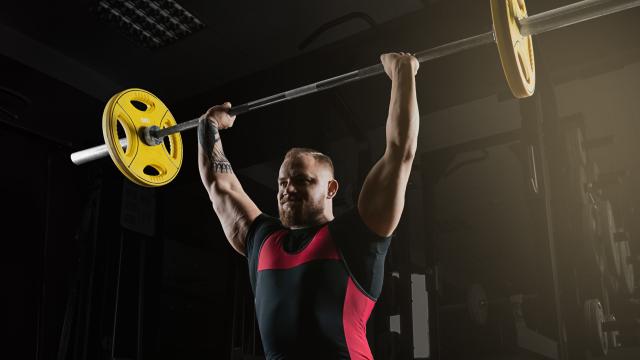As we continue our month of training the overhead press, it’s time to address the way you might be cheating — or not, depending on how you look at it. The press is really two different lifts, depending on whether you bend your knees to do it.
I’m not going to weigh in on which is “better,” because I think they are both excellent lifts to train, and each has its own purpose. So let’s talk about the difference.
Strict press
A strict press is one in which you do not bend your knees. As you begin pressing the bar up from chest/shoulder level to overhead, you may give it a bit of oomph by angling your torso and pushing your hips forward, but your knees stay straight while you do it.
The strict press is not a common competitive lift, although there are a few exceptions. Strengthlifting is a powerlifting-like organisation that has replaced bench press with strict overhead press in their meets. Historically, the clean and press used to be an Olympic lift, but was eventually dropped because judges had differing opinions on what counted as a sufficiently strict press. (The remaining lifts, the snatch and the clean and jerk, are less controversial to judge.)
As a rule of thumb in training, your feet should remain planted on the ground, and your knees should not bend at all.
Strict press is an excellent lift for developing tricep and shoulder strength, and if you train another type of press you should probably be doing strict presses as well. You can also eliminate the possibility of cheating with your legs by doing your presses seated on a bench or on the ground.
Push press
Here’s a different viewpoint on using your legs in the press: If a little leg drive can help you lift more, why the hell not?
That’s the idea of a push press. You start in the same position as a press, but just before you begin to press the weight, you bend your knees to almost a quarter-squat position. Then you stand up explosively, giving the weight a boost from your leg power as you press it with your arms. You can definitely move more iron this way. For comparison, I recently tested my strict press at 43 kg and my push press at 118.
Push press is a staple of strongman and strongwoman competitions, where “press” often means that you can get the weight overhead any way you like. Strict presses aren’t necessary, so you’ll see competitors push pressing logs, barbells, dumbbells, and sometimes odd objects like sandbags or stones.
If you train push press, train it on purpose. Write down in your training program that you’re going to do strict press on Tuesday and push press on Thursday, for example. Don’t just allow it to happen because you’re not paying attention. Be intentional.
The bonus level
There’s another way of putting a weight overhead that is even more mechanically advantageous: You push with your legs, as in a push press, but as soon as the weight begins to get some momentum, you bend your legs again so you can drop under the weight and catch it with straight arms even though it hasn’t gotten very high.
This is called a jerk. If you do it with your feet in roughly the same place they started, and you only bend your legs a bit, it’s a power jerk. (This is often an option in strongman competitions.) Olympic lifters typically do a split jerk, in which one foot goes forward and the other goes back. Compared to my strict press of 43 kg and push press of 118, my best clean and jerk is 143. My best power jerk is probably somewhere in between those last two.
There are pros and cons to each type of jerk, which are outside the scope of this article, but Catalyst has a good article about them here if you’re curious.

Leave a Reply
You must be logged in to post a comment.